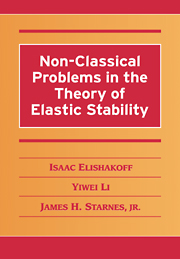Book contents
- Frontmatter
- Contents
- Preface: Why Still Another Book on Stability?
- 1 Mode Localization in Buckling of Structures
- 2 Deterministic Problems of Shells with Variable Thickness
- 3 Stochastic Buckling of Structures: Monte Carlo Method
- 4 Stochastic Buckling of Structures: Analytical and Numerical Non-Monte Carlo Techniques
- 5 Anti-Optimization in Buckling of Structures
- 6 Application of the Godunov-Conte Shooting Method to Buckling Analysis
- 7 Application of Computerized Symbolic Algebra in Buckling Analysis
- Bibliography
- Author Index
- Subject Index
7 - Application of Computerized Symbolic Algebra in Buckling Analysis
Published online by Cambridge University Press: 06 January 2010
- Frontmatter
- Contents
- Preface: Why Still Another Book on Stability?
- 1 Mode Localization in Buckling of Structures
- 2 Deterministic Problems of Shells with Variable Thickness
- 3 Stochastic Buckling of Structures: Monte Carlo Method
- 4 Stochastic Buckling of Structures: Analytical and Numerical Non-Monte Carlo Techniques
- 5 Anti-Optimization in Buckling of Structures
- 6 Application of the Godunov-Conte Shooting Method to Buckling Analysis
- 7 Application of Computerized Symbolic Algebra in Buckling Analysis
- Bibliography
- Author Index
- Subject Index
Summary
For the public at large and even for most scientists, numerical calculation and scientific calculation have become synonymous. … However, numerical calculation does not rule out algebraic calculation. … And, the power of computers does not solve everything.
J. H. Daventport, Y. Siret, and E. TournierThere are…problems in mechanics for which standard numerical procedures are available but which could be solved more elegantly and accurately using analytical methods if the formula work could be overcome.
J. Jensen and F. NiordsonComputer algebra systems can solve many problems more quickly than a human being. In our experience it is not unusual for a computer system to solve a problem which has been taxing a capable mathematician for several months, in a few minutes. One wonders how many tractable problems remain unsolved or have been forgotten about simply because they are making excessive demands on a researcher's time and sanity!
C. Wooff and D. HodgkinsonIn this chapter, we deal with the analytic, symbolic computation for buckling analysis. Symbolic algebra can significantly reduce the tedium of analytic computation and simultaneously increases its reliability. It has great impact on scientific computation, as more and more analytically minded researchers are using computers, which have been traditionally associated with “number crunching.” Analytic work can now be extended as far as possible, and the numerical side of the analysis can be “delayed.” Calculations with arbitrary arithmetic precision along with the automatic generation of computer codes have opened up more possibilities of computer use. In this chapter, we use a classical problem buckling of non-isotropic plate to illustrate the application of symbolic algebra, a neo-classical analytic-numerical tool.
- Type
- Chapter
- Information
- Non-Classical Problems in the Theory of Elastic Stability , pp. 268 - 290Publisher: Cambridge University PressPrint publication year: 2001



